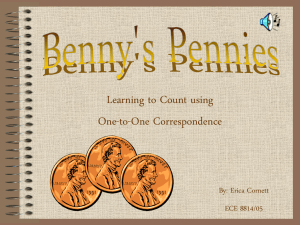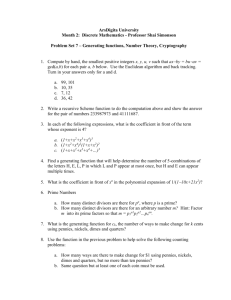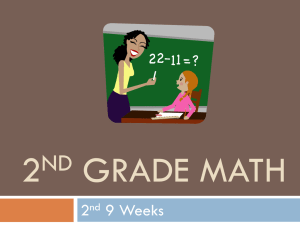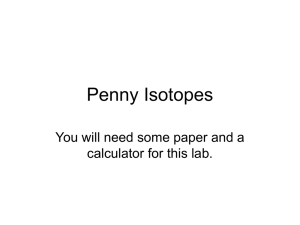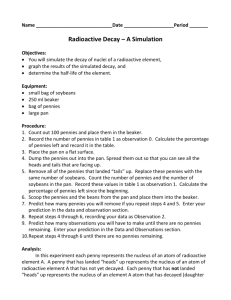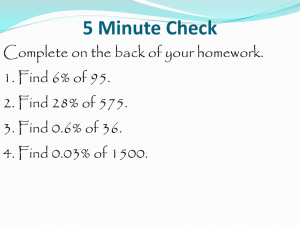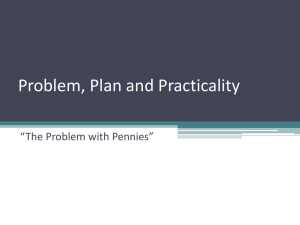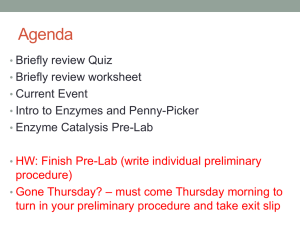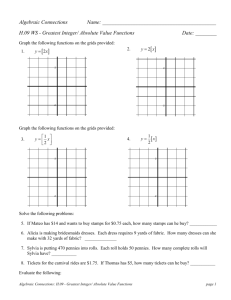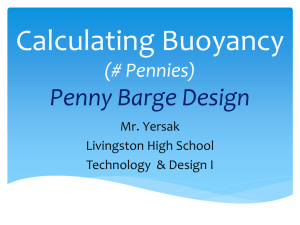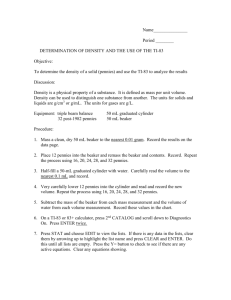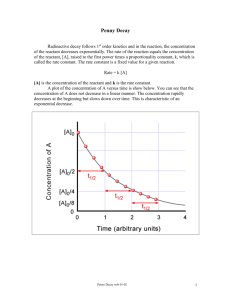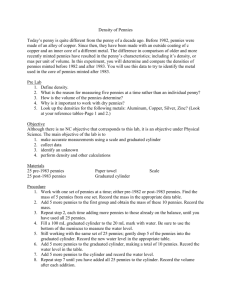Integers Day 4 - secondarymathcommoncore
advertisement
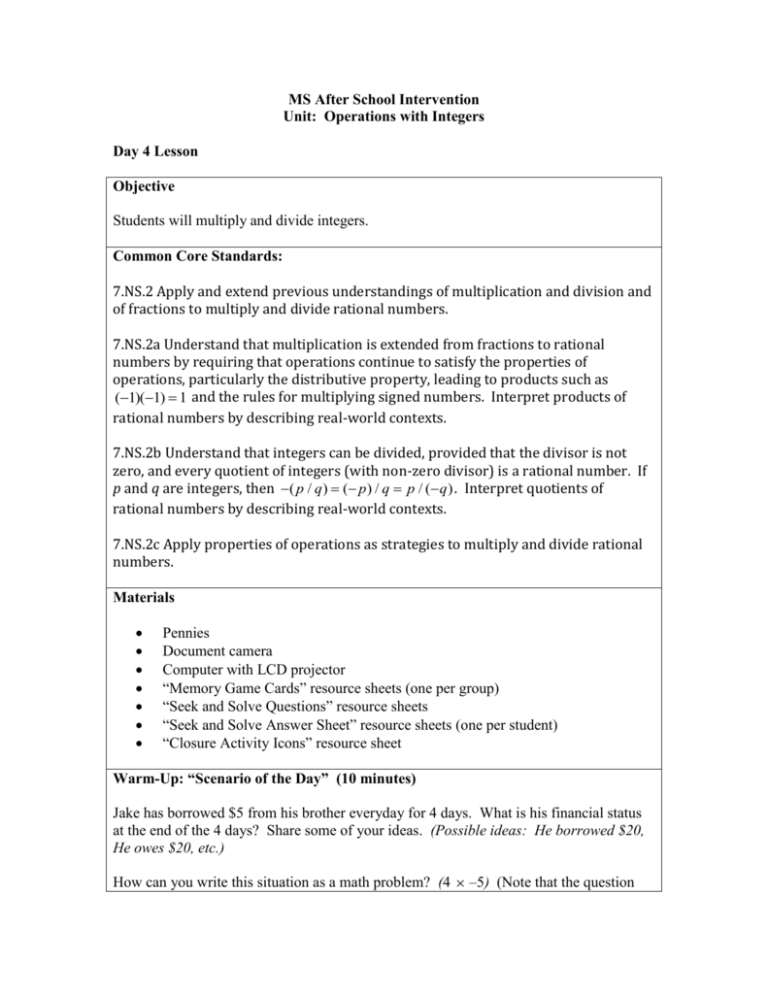
MS After School Intervention Unit: Operations with Integers Day 4 Lesson Objective Students will multiply and divide integers. Common Core Standards: 7.NS.2 Apply and extend previous understandings of multiplication and division and of fractions to multiply and divide rational numbers. 7.NS.2a Understand that multiplication is extended from fractions to rational numbers by requiring that operations continue to satisfy the properties of operations, particularly the distributive property, leading to products such as (1)(1) 1 and the rules for multiplying signed numbers. Interpret products of rational numbers by describing real-world contexts. 7.NS.2b Understand that integers can be divided, provided that the divisor is not zero, and every quotient of integers (with non-zero divisor) is a rational number. If p and q are integers, then ( p / q) ( p) / q p / (q) . Interpret quotients of rational numbers by describing real-world contexts. 7.NS.2c Apply properties of operations as strategies to multiply and divide rational numbers. Materials Pennies Document camera Computer with LCD projector “Memory Game Cards” resource sheets (one per group) “Seek and Solve Questions” resource sheets “Seek and Solve Answer Sheet” resource sheets (one per student) “Closure Activity Icons” resource sheet Warm-Up: “Scenario of the Day” (10 minutes) Jake has borrowed $5 from his brother everyday for 4 days. What is his financial status at the end of the 4 days? Share some of your ideas. (Possible ideas: He borrowed $20, He owes $20, etc.) How can you write this situation as a math problem? (4 –5) (Note that the question refers to 4 days and borrowing $5 each day.) Multiplying by Grouping Pennies (20 minutes) Separate the class into pairs and give each set of partners a bag of pennies. Instruct the class that a “heads up” penny represents a positive unit, while a “tails up” penny represents a negative unit. Next, explain that multiplication can be thought of as multiple groups of these units. For instance, 4 3 can be thought of as four groups of three positive units. Illustrate this by grouping the pennies into four groups of three on the document camera. Be sure to write the problem next to the representation. Ask the class to evaluate the problem, based on what they see. Have one student answer the problem and explain how they did it. If the student counts each penny, prompt the class to try counting by threes instead. Have the students use their pennies to complete the Grouping Pennies Activity in their groups. As a class, discuss what they discovered. Multiplication as Area (15 minutes) Read the following problem to the students: “A kitchen needs to be tiled using 1 ft 1 ft tiles. The room is 8 ft 12 ft. How many tiles are necessary?” Use the following application to illustrate the problem: http://nlvm.usu.edu/en/nav/frames_asid_322_g_1_t_1.html?from=topic_t_1.html Explain to the students how the area of a rectangle can also be used to represent multiplication. You may wish to show 8 groups of 12 pennies again, and then push them together to form the same rectangle as depicted on the application. Use the application to illustrate more problems for the students. Have the students choose the numbers. Discuss the rules of multiplication further. Be sure to discuss the rule for a negative times a negative, which has not yet been addressed. Integer Memory (20 minutes) Have students get into groups of three or four. Each group will get a set of memory cards that are pre-cut and placed in an envelope. Students will play memory by matching a problem to an answer. Allow them to use pennies and/or a coordinate plane, if necessary. Seek and Solve (20 minutes) Post several questions for multiplying and dividing integers around the room. The answer to a question is at the top of another question posted. Students will start at a randomly assigned question. Once they solve that question, they seek for the solution. Once they find the solution, they answer the new question. Students should write their work and solutions on the “Seek and Solve Answer Sheet.” Solution: If a student begins at station A, the correct order is A-G-E-K-M-D-P-I-F-C-NL-J-B-O-H-A. Closure – Circle of Knowledge (10 minutes) Seat students in groups of three or four and have them form a circle with their chairs. Display the pictures/icons while each group of students discusses the following prompts: --The question mark—what is a question that arose? --The brain—what is a thought you have had? After the small groups have discussed, form a large circle and ask students to share out responses from their small group discussion. Grouping Pennies Activity 1. Use your pennies to represent the problem 5 2 by creating 5 groups of 2 units each. Fill in the answer below, and sketch your representation in the space provided. Problem: 5 2 ________ Sketch: 2. Regroup your pennies into 2 groups of 5 units. Does this change the problem at all? Fill in the problem below, and sketch your representation in the space provided. Problem: _______ _______ = _______ Sketch: 3. Group your pennies into 8 groups of 3 units, and then regroup them into 3 groups of 8 units. What two problems did you create? Fill in each problem and sketch both. Problem: _______ _______ = _______ Sketch: Problem: _______ _______ = _______ Sketch: 4. Write a rule for any pattern you noticed in problems 1–3. 5. Rewrite the following problems, using your rule in #4. Circle the problem you think would be easier to group using pennies. Be prepared to explain why. a) 10 3 = ______ ______ b) 12 4 = ______ ______ c) 13 4 = ______ ______ 6. Group your pennies into 5 groups of –4 units. Fill in the problem below, and sketch your representation. Problem: _______ _______ = _______ Sketch: 7. Can you regroup your pennies into –4 groups of 5? Why or why not? If you could, what problem would this represent? Problem: _______ _______ How can you figure out the answer to this problem, based on your rules in problem #3? What is the answer? 8. How might you change the problem 6 7 so that you can put it in groups and still get the correct answer? Write the new problem below, use your pennies to find the answer, and sketch your representation below. Problem: _______ _______ = _______ Sketch: 9. Fill in the following rules, based on what you have done. a) Positive groups of positive units give __________ solutions. b) Positive groups of negative units give ___________ solutions. c) Negative groups of positive unit would give ____________ solutions, if they were possible. d) You can ____________ a problem and still get the same answer. 10. Use the pennies and what you have learned to help you solve the following problems. a) 11 4 = d) 4 8 = b) 6 8 = e) 6 5 = c) 7 5 = f) 5 9 = Closure Activity Icons Source: www.heppell.net/horizontal/cognition.html Source: commons.wikimedia.org/wiki/File:Question_mark... Memory Game Cards –2(5) –8 –4(–3) –3 4 9 10 –9 –12 –5(–2) –3 3 –2(–4) –3(–3) 4 –2 8 –10 12 –1(7) –1(–7) –6 –3(–2) 7 –2 3 –7 –25 6 Memory Game Cards –5(5) 25 5(5) 25 –5 –5 –3 –24 –8 –25 –5 5 –24 8 3 16 –4 2 –20 –40 –2 –16 –4 4 –2 –40 2 –10 –5 –4 –10 5 20 –25 Seek and Solve Questions A. Answer: 15 E. Answer: 9 –5(3) B. Answer: 24 –5(–4) F. Answer: 30 20 –4 C. Answer: –40 –8(5) Answer: –15 G. –45 –5 –15(2) Answer: –9 D. –25 –5 H. Answer: –24 –3(–5) Answer: –6 I. M. Answer: 40 –18 2 –5(–6) Answer: –20 J. N. –30 –5 –3(–8) K. Answer: 20 O. –8(–5) L. Answer: 6 Answer: –5 12(–2) P. Answer: 5 –100 5 Answer: –30 –48 8 Seek and Solve Answer Sheet Station Letter Work Answer

